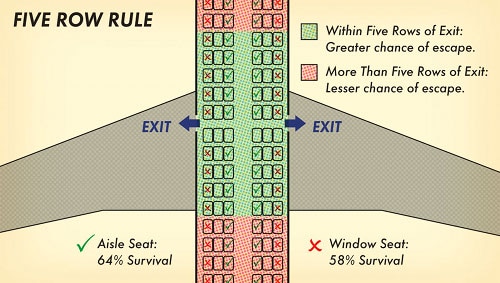Remember the Five Row Rule

A few years ago, Popular Mechanics put out an article that analyzed every commercial plane crash in the U.S. and where survivors were sitting in each accident. The article’s author concluded that in the event of a crash, the safest place to be sitting was in the back of the plane. After reading that article, I started to sit in the back of airplanes. Come to find out, Popular Mechanics’ conclusion isn’t well supported by expert research.
According to the folks who dedicate their lives to studying plane crashes, the statistics are inconclusive because every plane crash is different. Sure, many crashes are nose-first, thus making the back of the plane safer, but several are tail-first (as with the recent incident in San Francisco) or wing-first. You just don’t know what kind of crash you’ll be in. Instead of worrying about whether your seat is near the back, focus on finding a seat near an exit. According to researcher Ed Galea, those who survive a plane crash typically only have to move an average of five rows to escape. Beyond five rows the chance of getting out alive decreases.
The best seat to have is in the exit row as you’d be the first one out should you need to exit. If you can’t snag that seat, go for the aisle. Not only do you have easier access to the lavatory during flight, you also have a 64% chance of survival compared to the 58% chance you’d have sitting in a window seat. Also avoid bulkhead rows. Sure, you have more leg room, but the walls don’t “give” as much as seats when you collide with them in a crash.
Galea admits that there are exceptions to the Five Row Rule; he’s found people that successfully moved 19 rows to get to an exit. Moreover, even if you’re just two rows away from an exit, there’s always the chance that the exit door will be blocked or jammed. Overall, though, your chances of survival will increase if you’re within five rows of an exit.
...[ Continue to next page ]
Share This Post














